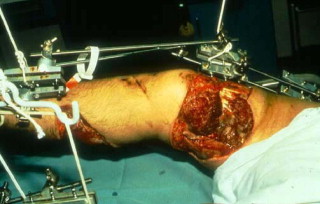
On July 6, 2025, in Nanjing, China, a construction worker fell onto a steel rod that impaled him from pelvis to chest. That evening, doctors battled relentlessly for five hours, inch by inch, against death.
The midnight alert
The phone’s shrill ring pierced through the oppressive summer quiet just after midnight.
Professor Ji Zhenling, head of Nanjing Jiangbei Hospital, barely roused from sleep, felt the warmth of his pillowcase still against his cheek. His hand instinctively located the phone in the dark.
“A man has fallen from scaffolding about three or four stories high,” came the urgent voice. “A steel rod (3 centimeters thick) has impaled him from pelvis to chest. He’s currently in the emergency room.”
Ji was already in motion, memories of the operating room flashing in his mind: the incessant beeping of machines, the rhythmic whir of the ventilator, and the muted scraping of rubber shoes on the hospital floor. He could already detect it: the sharp sting of iodine mingling with blood. He sensed death’s presence in the building, waiting.
He quickly dressed and got into the car. The engine roared to life, disturbing the city’s uneasy slumber, and his heartbeat quickened to match its intensity. Once again, the night beckoned him to race against death.
CT/3D reconstruction illustrates the rod’s trajectory through pelvis, abdomen, and chest, compressing major vessels like explosives in a minefield.
The descent
At approximately 10 p.m., a scream pierced the muggy outskirts of Nanjing: sharp, desperate, then stillness.
Zhang, a construction worker, lost his footing. His body crashed to the ground with brutal finality, but the fall didn’t end there. An upright, ribbed steel rod, thick as a man’s thumb, awaited him. It pierced his pelvis and vanished upward, a grotesque punctuation mark on the night.
His coworkers arrived to a horror. Zhang was firmly pinned by the steel, his body offered as a sacrifice to the night. His breaths were ragged and wet, blood filling his mouth. His face contorted in pain, and his clothing was drenched in sweat and blood.
The paramedics exchanged no words. They shared a single look. The trajectory was all wrong: the rod entered his lower body and reemerged just beneath his right armpit, as if his torso were merely a sheath.
There was no established protocol, no checklist, only urgency.
Sparks illuminated the darkness as they sawed through the rod 15 centimeters from his skin, leaving most of its cold length embedded within him. IV access was achieved, fluids were administered, and the ambulance wailed into the night, slicing through the darkness. Another race against death had begun.
The strategy meeting
As Ji entered the emergency ward, the smell assaulted him first, a sharp combination of disinfectant and blood. Heads turned. Dozens of eyes focused on him, filled with a desperate, unspoken appeal.
A CT technician gestured toward the glowing screen. The image was a disaster map: a steel rod slicing straight through the man’s core, grazing the aorta, skimming the vena cava, and pressing against the liver. It looked less like an injury and more like a lit fuse.
CT scan reveals the steel rod piercing upward through his torso, its path perilously close to major vessels.
“Gather everyone,” Ji commanded, his voice resolute, an order etched into the urgency of the moment.
Within moments, the ward buzzed with activity. General surgeons, anesthesiologists, cardiothoracic specialists, orthopedists, and urologists. They assembled one by one. A war council converging around a body transformed into a battlefield.
On the table, the patient lay intubated, his chest already drained. A cardiovascular surgeon stood poised, anticipating the worst: the possibility that the steel had ruptured a major vessel, and that a single misstep could unleash a flood no human strength could control.
Ji secured his mask and adjusted it over his face. His eyes, visible above the blue fabric, glinted like a scalpel.
“Keep in mind,” he addressed the room, “This is not surgery; this is bomb disposal. We advance in millimeters, not centimeters.”